View current page
...more recent posts
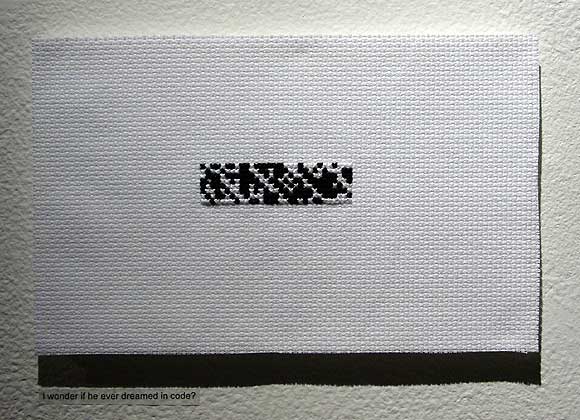
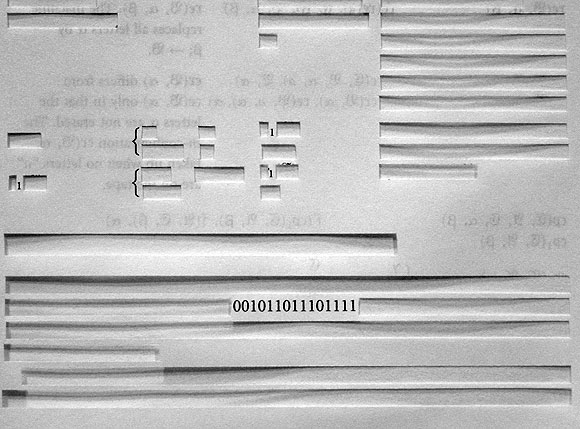
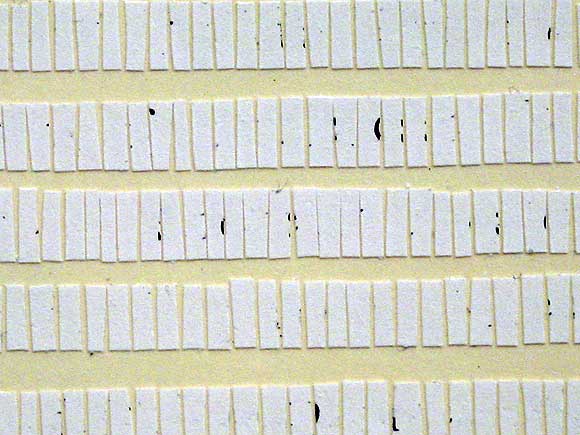
Some photos I took at Cody Trepte's show (for Alan Turing), at NYU/Tisch School of the Arts' Gulf & Western Gallery, 721 Broadway. More about the show is here. At the top is a "binary cross stitch" similar to the one Trepte had in the Infinite Fill Show a while back. The middle image is an essay by pioneering computer scientist and codebreaker Turing with everything but the 1s and 0s removed (detail of a 33 page installation). The bottom image, another detail, is the negative space (spaces between words) in another Turing essay. The show is a non-standard take on "computer art" in the gallery context. The formal vocabulary is reductive (or accumulative) minimalism a la Yayoi Kusama's airmail stamp paintings, and while the subject matter is the language of both the computer and the computer scientist, it's treated not in a literal way but rather as an absence, or anti-content. As the press release explains, Turing was gay and accused in the not so swinging '50s of "acts of gross indecency." His "sentence" was an "experimental hormone therapy" consisting of estrogen injections to "reduce the libido." He died a couple of years later, apparently a suicide, but with questions lingering. Trepte's work is thus not the typical Buzz Lightyear computer-fetish celebration but rather an examination of the repressed, fragile, elegiac back story to the "machine that's changed our lives."
The exhibition's up through Saturday, Jan. 6. Gallery hours are 10am through 7pm weekdays, and noon to 5pm on Saturdays.
So, art in Miami 2006: a brief recap. It was this:
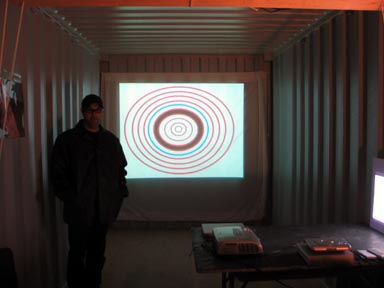
versus this:
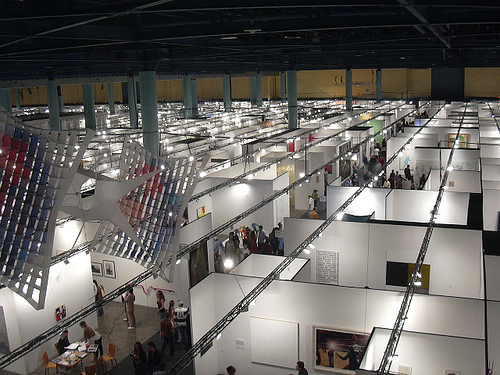
(Apologies to Paddy Johnson for the polemical use of her photos. The point is that the small, scurrying mammals of the New Art were defiantly underfoot as the dinosaurs munched their last wads of eucalyptus. Or put another way, that the starship Voyager navigated through Borg Space despite the latter's overwhelming hegemonic force. Also, thanks to Johnson for including this blog and my artMovingProjects show in her 2006 best of the web wrap-up. She's one of that rare tribe of artist/critics willing to wade in and critique both the gallery world and the web world, or perhaps attempt to knock their mutton heads together.)
(Also check out her worst of the web '06, which includes such deserving topics as Banksy, Lonelygirl15, and a certain artnet writer who will never be mentioned by name here.)

artist unknown - GIF enlarged X 10
update: non-fuzzy (preferred) version - 425 KB
"Subharmonic Duo" [mp3 removed]
The piano parts in the previous tune were adapted for bass and two intertwining lead synth parts. I gave the piano piece a new name since it's closer to this piece than its predecessor. The rhythm parts were done with a hardware sequencer triggering both itself and tuned drum sounds with long decays on an analog drum machine. The '70s-synth-plus-techno vibe is an homage to Keith Emerson's film scores of the mid '80s (for anime and live action) that I still listen to quite a bit.
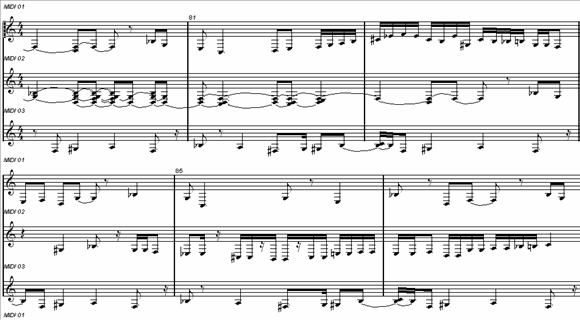
"Subharmonic Duo" (Piano) [mp3 removed]
Kind of a slow baroque modernist blues composition for piano, using the same notes as "Subharmonic Duo" minus the beats. The score above is an except near the end. (The title has been changed.)
"Dyspeptic Bass" [mp3 removed]
I spent the holidays working on songs and finally sat down with the manual and learned to use a hardware sequencer. I originally had the idea I would write all my material in the computer but someone on a chatboard I look at described the Electribe R-1 mkii as a "sketchbook" for rhythmic ideas and that idea appealed. (I got one a while back--they're pretty cheap--but had mainly been using it as a tone generator and a source of MIDI to mangle.) Of course the sketches can be recorded as audio or MIDI and developed further in the computer. The song above uses one of my first "drawings"--I kept the rhythm simple and put most of my energy into a kind of extended slow motion prog solo played on a different instrument, a software synth. [/music diary]
Update: this is the same basic melody as "Subharmonic Duo" but I called it "Dyspeptic Bass" because the synthesizer sounds gastronomically challenged. Maybe it's time for a Pink Floyd parody called "Gastronomy Domine."
In the comments to the previous post where I was complaining about the emphasis on timbre (musical sound or texture) in a recent New York Times story, p.d. reminds me that changes in timbre are the creative engine behind, like, all my favorite music (techno, hiphop, and so forth). He tells a great story about "Berry Gordy making the engineers build a radio transmitter and everyone heading out into the car to check how the motown test masters sounded...and remix, re-eq, recut, and test, etc...for the whole day because he knew if it didn't sound 'right' on the radio it wouldn't sell." p.d. points out how many current hiphop hits have built on such sonic refinements, from Motown right up through '90s drum and bass experiments, turning them into main attraction.
All true, but I don't think the sound scientist I was hectoring, Daniel Levitin, was talking about artists who consciously base their music on equalization or synth textures, a la the Detroit techno guys. He means monster hits, which I maintain rely as much on the marketing of personality and yes, old fashioned musical hooks. A good case in point was Cher's "Believe," to which the Times devoted an anatomy-of-a-chart-topper story several years ago. It was quite funny: Cher came off as the grumpy CEO of her corporate musical enterprise, complaining at development meetings to the teams that had various parts of the song parceled out to them. Seems they had the verses in the pipeline for six years but the chorus was eluding them (or maybe the reverse). She admonished one team to "go out and get more pain in their lives" to develop an effective hook. Someone had some weak lines and tried them with the vocoder and the rest is musical history. So, yes, timbre put the song over the top but the hit also resulted from nuts and bolts Tin Pan Alley songwriting. The acoustic scientist Levitin has discovered an interesting fact about current music but is announcing it as a principle. And no offense to anyone in a lab about the dig in the last post--my point is mainly that art is its own kind of rocket science but journalists love to dumb it down by reducing it to something quantifiable.
One should always be leery when scientists attempt arts criticism. The New York Times is not leery--it eats it up, witness all the stories about fractal analysis of Pollock paintings. Yesterday it ran an article about Daniel Levitin, a big time pop music producer who pulled out of the game in the early '80s and became an acoustic scientist. Check out this line of argument:
The subtlest reason that pop music is so flavorful to our brains is that it relies so strongly on timbre. Timbre is a peculiar blend of tones in any sound; it is why a tuba sounds so different from a flute even when they are playing the same melody in the same key. Popular performers or groups, Dr. Levitin argued, are pleasing not because of any particular virtuosity, but because they create an overall timbre that remains consistent from song to song. That quality explains why, for example, I could identify even a single note of Elton John’s “Benny and the Jets.”I believe it was the Beatles' manager Brian Epstein who had the industry visions based on the boys' looks, pop hook writing ability, stage energy and the like. After their breakthrough to larger fame Pete Townshend was still calling the production of their tracks "flippin' lousy" (the '60s TV interview where he says that is one of the funnier moments in The Kids Are Alright). As for being able to recognize a piano note from "Benny and Jets," who would want to? After the popular musical creativity of groups such the Jimi Hendrix Experience and the Doors, "Benny" was pure retrograde fluff. Levitin's idea that musical fame is based on timbre (or the continuity thereof from song to song) is the kind of cynicism that supposedly drove him out of the music biz years ago. As for the success of Elton John, that can be attributed to marketing and the burnout of '60s music rather than "timbre" (as long as we're being cynical).
“Nobody else’s piano sounds quite like that,” he said, referring to Mr. John. “Pop musicians compose with timbre. Pitch and harmony are becoming less important.”
Dr. Levitin dragged me over to a lab computer to show me what he was talking about. “Listen to this,” he said, and played an MP3. It was pretty awful: a poorly recorded, nasal-sounding British band performing, for some reason, a Spanish-themed ballad.
Dr. Levitin grinned. “That,” he said, “is the original demo tape of the Beatles. It was rejected by every record company. And you can see why. To you and me it sounds terrible. But George Martin heard this and thought, ‘Oh yeah, I can imagine a multibillion-dollar industry built on this.’
“Now that’s musical genius.”
Happy New Year.
